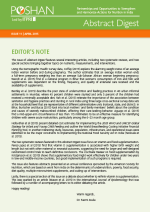 This issue of Abstract Digest features several interesting articles, including two systematic reviews, and two special sections bringing together topics on nutrients, measurements, and interventions.
This issue of Abstract Digest features several interesting articles, including two systematic reviews, and two special sections bringing together topics on nutrients, measurements, and interventions.
Using the Demographic Health Survey data, Coffey (2015) explains the alarming weight status of an average Indian woman before and during pregnancy. The author estimates that an average Indian woman ends a full-term pregnancy weighing less than an average Sub-Saharan African woman beginning pregnancy. Wendt et al. (2015) find in a national program in Bihar that women’s consumption of iron and folic acid supplements was dependent on the timing, frequency, and quality of antenatal care received and the availability of supplements.
Bentley et al. (2015) describe the poor state of undernutrition and feeding practices in 40 urban informal settlements in Mumbai, where 45 percent children were stunted and only 5 percent of the children had received a minimally acceptable diet. Rah et al. (2015) reiterate the importance of the association between sanitation and hygiene practices and stunting in rural India using three large cross-sectional survey data sets at the household level that are representative of different administrative units (national, state, and district). In Bihar, Burtscher and Burza (2015) look into local mothers’ and family members’ beliefs about the condition and causes of severely malnourished children, affecting their care-seeking behavior. Aguayo et al. (2015) find a mid-upper-arm circumference of less than 115 millimeters to be an effective measure for identifying children with severe acute malnutrition, particularly among the 6–23 month age group.
Holla-Bhar et al (2015) present detailed cost estimates for implementing the 2003 WHO and UNICEF Global Strategy for Infant and Young Child Feeding and outline the World Breastfeeding Costing Initiative Financial Planning Tool. In another interesting study, resources, population, infrastructure, and operational issues were identified to be the major constraints to implementing the National Food Security Act in India (Tanksale et al. 2015).
The two systematic reviews featured in this Abstract Digest issue focus on vitamin and food supplementation. Perez-Lopez et al (2015) find that vitamin D supplementation is associated with higher birth weight and length but not with other maternal or neonatal outcomes, suggesting the need for larger and well-designed randomized control trials to reach definitive conclusions. The Cochrane Review on food supplementation by Kristjansson et al. (2015) shows that supplementary food might work effectively for children under two years in low-and middle-income countries, but good implementation of such programs is required.
This issue also features abstracts presented at an annual conference sponsored by the American Society for Nutrition, which are based on work from India on the determinants of undernutrition, poverty, food security, diet quality, multiple micronutrient supplements, and scaling-up of interventions.
Lastly, there is a special section of this issue on a debate about whether to rethink vitamin A supplementation. This was sparked by an article (Mason et al. 2015) in the International Journal of Epidemiology that was followed by a number of accompanying letters to its editor debating the article.


